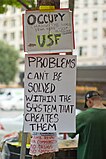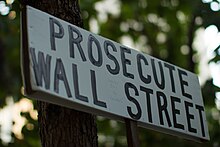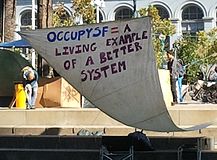
Occupy Los Angeles was one of the many occupy movements in the United States, following the original Occupy Wall Street (OWS) protest. Participants of Occupy L.A. first met at Pershing Square on September 23, 2011. Activists came to consensus to occupy public space in solidarity with the growing movement. Occupiers first marched in Los Angeles on September 24, 2011. They next protested a fundraiser being held in Hollywood at the House of Blues for President Obama. Participants met at Pershing Square every subsequent night to plan out the logistics of an occupation set to begin on October 1, 2011. After debating potential locations around Los Angeles, people decided on the lawns around City Hall. Tents first manifested on October 1, 2011 on the grounds of Los Angeles City Hall.

Occupy Portland was a collaboration that began on October 6, 2011 in downtown Portland, Oregon as a protest and demonstration against economic inequality worldwide. The movement was inspired by the Occupy Wall Street movement that began in New York City on September 17, 2011.

Occupy San José was a peaceful protest and demonstration in City Hall Plaza in San Jose, California. The demonstration was inspired by Occupy Wall Street and is part of the larger "Occupy" protest movement. The aim of the demonstration was to begin a sustained occupation in downtown San José, the 10th largest city in the United States, to protest perceived corporate greed and social inequality, including opposing corporate influence in U.S. politics, the influence of money and corporations on democracy and a lack of legal and political repercussions for the global financial crisis.

Occupy Seattle was a series of demonstrations in Seattle, Washington, United States in 2011 and 2012, that formed part of the wider Occupy movement taking place in numerous U.S. and world cities at that time. The demonstrations were particularly focused on the city's downtown area including Westlake Park and Seattle City Hall; their stated aim was to oppose wealth inequality, perceived corporate greed, and corruption in the banking and economic systems of the United States.

Occupy Boston was a collective of protesters that settled on September 30, 2011 in Boston, Massachusetts, on Dewey Square in the Financial District opposite the Federal Reserve Bank of Boston. It is related to the Occupy Wall Street movement that began in New York City on September 17, 2011.

The Occupy movement was an international populist socio-political movement that expressed opposition to social and economic inequality and to the perceived lack of real democracy around the world. It aimed primarily to advance social and economic justice and different forms of democracy. The movement has had many different scopes, since local groups often had different focuses, but its prime concerns included how large corporations control the world in a way that disproportionately benefits a minority, undermines democracy and causes instability.
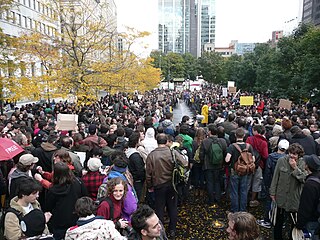
Occupy Canada was a collective of peaceful protests and demonstrations that were part of the larger Occupy Together movement which first manifested in the financial district of New York City with Occupy Wall Street, and subsequently spread to over 900 cities around the world.
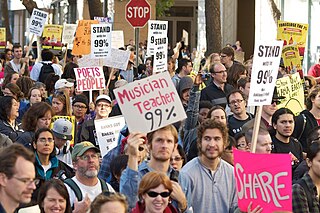
Occupy Oakland refers to a collaboration and series of demonstrations in Oakland, California, that started in October 2011. As part of the Occupy movement, protesters have staged occupations, most notably at Frank H. Ogawa Plaza in front of Oakland City Hall.
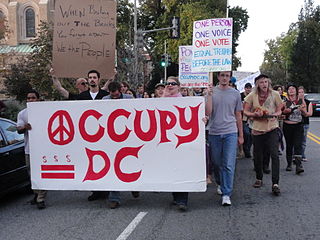
Occupy D.C. was an occupation of public space in Washington, D.C. based at McPherson Square and connected to the Occupy movements that sprung up across the United States in Fall 2011. The group had been demonstrating in McPherson Square since October 1, 2011, and in Freedom Plaza since October 6. Despite crackdowns on other Occupy projects across the country, federal authorities claimed on November 15 that they have no plans to clear McPherson Square Park. The National Park Service decided against eviction after meeting with activists and discussing health and safety conditions.

Occupy Houston is a Houston, Texas-based activist group best known for alleged plots against it by the Federal Bureau of Investigation, investigated and called out on in court by Occupy protester Ryan Shapiro, and for being set up by the Austin Police Department. Occupy Houston was a collaboration that has included occupation protests that stand in solidarity with Occupy Wall Street. The planned occupation officially started in Houston, Texas on Thursday October 6, 2011 when protesters returned from JP Morgan Chase Tower to establish an encampment at Hermann Square Plaza. During the JPMorgan Chase demonstration there were not any confrontations with the police and numerous different passerby were reported to have sympathized with the tone of the protesters. That same night the police were reported to have commented on how well behaved the protesters were.

Occupy Nashville was a collaboration that began with demonstrations and an occupation located at Legislative Plaza in Nashville, Tennessee. Special legislation attempting to oust the Occupy Nashville demonstration passed the Tennessee House of Representatives and Tennessee Senate in February 2012.

The Occupy movement began in the United States initially with the Occupy Wall Street protests in New York City, but spread to many other cities, both in the United States and worldwide. This list article is an alphabetical, non-chronological summary of Occupy events that have occurred in cities in the United States.

Occupy St. Louis (OccupySTL) was a postpartisan people's movement that began on October 1, 2011 as a peaceful protest against corporate greed, its influence over the economy, its corruption of government, and ensuing inequality. Although people possess differing viewpoints and diversity of views is a central tenet, commonly held themes seek an equal playing field in the economy with more equal opportunities for all people as well as accountability for corporate and financial malfeasance. Many of those in the movement argue that structural, systemic change is necessary and that incremental reform is insufficient and in any case not possible without popular countervailing power to the power of moneyed interests. Occupy St. Louis is in solidarity with the Occupy Wall Street movement. It is located at Kiener Plaza in downtown St. Louis near an area which includes many financial institutions such as commercial banks and the Federal Reserve Bank of St. Louis.
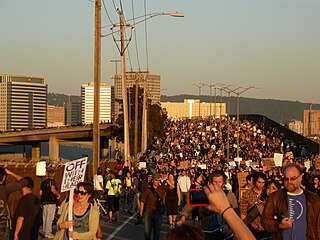
The following is a timeline of Occupy Oakland which began on Monday, October 10, 2011, as an occupation of Frank H. Ogawa Plaza located in front of Oakland City Hall in downtown Oakland, and is an ongoing demonstration. It is allied with Occupy Wall Street, which began in New York City on September 17, 2011, and is one of several "Occupy" protest sites in the San Francisco Bay Area. Other sites include Occupy San Francisco and Occupy San Jose.
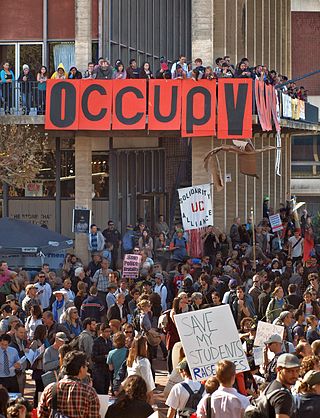
Occupy Cal included a series of demonstrations that began on November 9, 2011, on the University of California, Berkeley campus in Berkeley, California. It was allied with the Occupy Wall Street movement in New York City, San Francisco Bay Area Occupy groups such as Occupy Oakland, Occupy Berkeley, and Occupy San Francisco, and other public California universities. "Cal" in the name "Occupy Cal" is the nickname of the Berkeley campus and generally refers specifically to UC Berkeley.

Occupy Baltimore was a collaboration that included peaceful protests and demonstrations. Occupy Baltimore began on October 4, 2011, in Baltimore, Maryland, in McKeldin Square near the Inner Harbor area of Downtown Baltimore. It is one of the many Occupy movements around the United States and worldwide, inspired by Occupy Wall Street.

The UC Davis pepper spray incident occurred on November 18, 2011, during an Occupy movement demonstration at the University of California, Davis. After asking the protesters to leave several times, university police pepper sprayed a group of student demonstrators as they were seated on a paved path in the campus quad. The video of UC Davis police officer Lt. John Pike pepper-spraying demonstrators spread around the world as a viral video and the photograph became an Internet meme. Officer Alex Lee also pepper sprayed demonstrators at Pike's direction.

Occupy Minneapolis (OccupyMN) is a grassroots collaboration that began in October 2011 with a series of demonstrations in Minneapolis, Minnesota. Protesters have staged numerous occupations, most notably of the Hennepin County Government Center plaza.
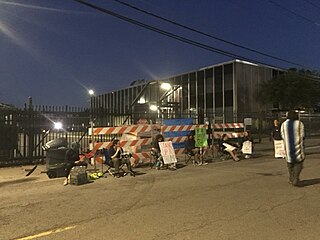
Occupy ICE is a series of protests, modeled on the Occupy Movement, that emerged in the United States in reaction to the Trump administration family separation policy, with a goal of disrupting operations at several U.S. Immigration and Customs Enforcement (ICE) locations.



